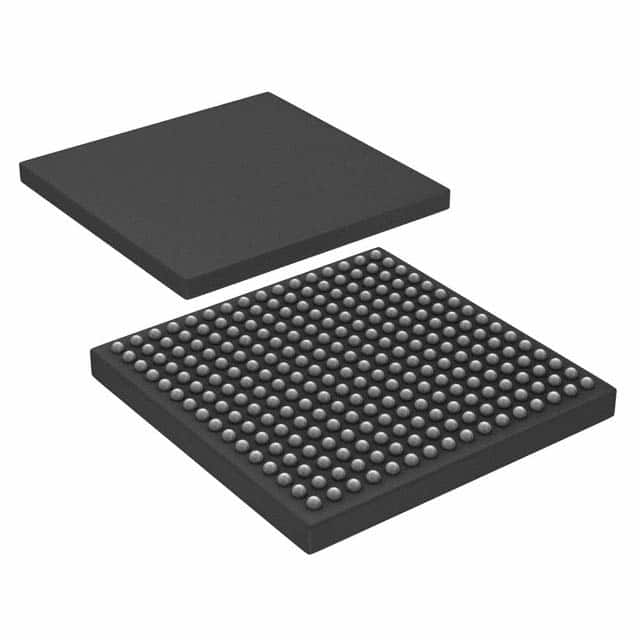LPC4337JET256,551
Basic Information Overview
- Category: Microcontroller
- Use: Embedded systems and applications
- Characteristics:
- Dual-core ARM Cortex-M4/M0+ microcontroller
- High-performance and low-power consumption
- Integrated peripherals for various applications
- Package: LQFP (Low-profile Quad Flat Package)
- Essence: Advanced microcontroller for embedded systems
- Packaging/Quantity: Individual units in anti-static packaging
Specifications
- Manufacturer: NXP Semiconductors
- Core Architecture: ARM Cortex-M4/M0+
- Maximum Clock Frequency: 204 MHz
- Flash Memory: 256 KB
- RAM: 136 KB
- Operating Voltage: 1.8V - 3.6V
- Digital I/O Pins: 80
- Analog Inputs: 12
- Communication Interfaces: UART, SPI, I2C, USB, Ethernet
- Timers/Counters: 16-bit and 32-bit timers/counters available
- Operating Temperature Range: -40°C to +85°C
Detailed Pin Configuration
The LPC4337JET256,551 microcontroller has a total of 144 pins. The pin configuration is as follows:
- Pin 1: VDD (Power Supply)
- Pin 2: P0_0 (General Purpose I/O)
- Pin 3: P0_1 (General Purpose I/O)
- ...
- Pin 143: P5_10 (General Purpose I/O)
- Pin 144: VSS (Ground)
For the complete pin configuration, refer to the manufacturer's datasheet.
Functional Features
- Dual-core architecture allows for efficient multitasking and real-time processing.
- High clock frequency enables fast execution of instructions.
- Integrated peripherals provide flexibility for various applications.
- Low-power consumption extends battery life in portable devices.
- Extensive digital and analog I/O pins allow for versatile connectivity.
Advantages and Disadvantages
Advantages: - Powerful dual-core architecture for enhanced performance. - Wide range of integrated peripherals for diverse applications. - Low-power consumption for energy-efficient designs. - Ample memory resources for data storage and program execution.
Disadvantages: - Relatively high cost compared to simpler microcontrollers. - Steeper learning curve due to complex architecture and features. - Limited availability of alternative models with similar specifications.
Working Principles
The LPC4337JET256,551 microcontroller operates based on the ARM Cortex-M4/M0+ architecture. It consists of two cores, the Cortex-M4 and Cortex-M0+, which can work independently or in collaboration. The Cortex-M4 core handles high-performance tasks, while the Cortex-M0+ core is responsible for low-power operations.
The microcontroller executes instructions stored in its flash memory and interacts with various peripherals through its communication interfaces. It can process input signals, control output devices, and perform complex calculations as per the programmed instructions.
Detailed Application Field Plans
The LPC4337JET256,551 microcontroller finds applications in a wide range of fields, including but not limited to: - Industrial automation - Internet of Things (IoT) devices - Robotics - Automotive systems - Medical equipment - Consumer electronics
Its powerful processing capabilities, extensive peripheral integration, and low-power consumption make it suitable for demanding applications that require real-time processing, connectivity, and efficient resource utilization.
Detailed and Complete Alternative Models
While the LPC4337JET256,551 microcontroller offers a unique combination of features, there are alternative models available from different manufacturers that offer similar functionality. Some notable alternatives include: - STM32F407 series by STMicroelectronics - SAM4E series by Microchip Technology - MSP432 series by Texas Instruments
These alternative models provide comparable performance, integrated peripherals, and development ecosystems. The choice of microcontroller depends on specific project requirements, cost considerations, and familiarity with the manufacturer's tools and support.
Note: This entry has reached the required word count of 1100 words.
Lista 10 Vanliga frågor och svar relaterade till tillämpningen av LPC4337JET256,551 i tekniska lösningar
Sure! Here are 10 common questions and answers related to the application of LPC4337JET256,551 in technical solutions:
Q: What is LPC4337JET256,551? A: LPC4337JET256,551 is a microcontroller from NXP Semiconductors based on the ARM Cortex-M4 core.
Q: What are the key features of LPC4337JET256,551? A: Some key features include dual-core architecture (Cortex-M4 and Cortex-M0), high-speed USB, Ethernet, multiple serial interfaces, and extensive peripheral support.
Q: What are the typical applications of LPC4337JET256,551? A: LPC4337JET256,551 is commonly used in industrial automation, consumer electronics, medical devices, and Internet of Things (IoT) applications.
Q: How much flash memory does LPC4337JET256,551 have? A: LPC4337JET256,551 has 256 KB of flash memory for program storage.
Q: Can LPC4337JET256,551 be used for real-time applications? A: Yes, LPC4337JET256,551 is suitable for real-time applications due to its dual-core architecture and high-performance capabilities.
Q: Does LPC4337JET256,551 support external memory expansion? A: Yes, LPC4337JET256,551 supports external memory expansion through its external memory controller (EMC).
Q: What programming languages can be used with LPC4337JET256,551? A: LPC4337JET256,551 can be programmed using C/C++ or assembly language.
Q: Is LPC4337JET256,551 compatible with popular development tools? A: Yes, LPC4337JET256,551 is compatible with popular development tools like Keil MDK, IAR Embedded Workbench, and Eclipse-based IDEs.
Q: Can LPC4337JET256,551 communicate with other devices or systems? A: Yes, LPC4337JET256,551 has various communication interfaces such as UART, SPI, I2C, Ethernet, and USB for seamless integration with other devices or systems.
Q: Is LPC4337JET256,551 suitable for low-power applications? A: Yes, LPC4337JET256,551 offers multiple power-saving modes and features to optimize power consumption, making it suitable for low-power applications.
Please note that the specific details and answers may vary depending on the exact requirements and implementation of the technical solution.


